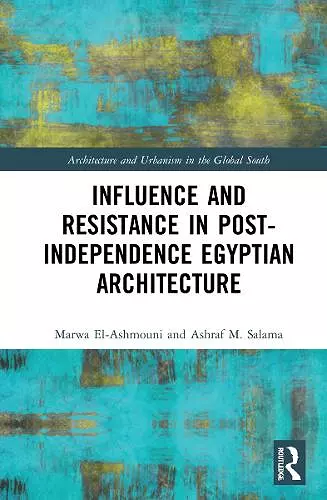Influence and Resistance in Post-Independence Egyptian Architecture
Ashraf M Salama author Marwa M El-Ashmouni author
Format:Hardback
Publisher:Taylor & Francis Ltd
Published:22nd Jul '22
Currently unavailable, and unfortunately no date known when it will be back
This hardback is available in another edition too:
- Paperback£41.99(9780367703639)

This book is an effort towards an in-depth understanding of the architectural discourse in Egypt developed over more than eight decades. It offers a distinctive theoretical interpretation of the forces shaping the kaleidoscopic shifts in Egyptian architecture through the analysis of the micro space of architectural representation of twentieth century Egyptian architecture. Predicated on historical contextualization, theoretical integration, and global conceptualization, Edward Said’s analytical method of contrapuntal reading and the spatial discourse analysis posited by C. Greig Crysler are lucidly assimilated to generate insights into various voices within the architectural discourse in Egypt. The analysis and critique of two important professional magazines, al-‘Imarah (1939–1959) and ‘Alam al-Bena’a (1980–2000), which shaped the collective psyche of both the academic and professional communities in Egypt and the wider region, coupled with the exploration of two other short-lived magazines, M‘imaryah (1982–1989) Medina (1998–2002), and other less-influential professional magazines, discloses the structure of attitude and reference or the exclusions and inclusions that defined the boundaries of the space of the discourse.
Influence and Resistance in Post-Independence Egyptian Architecture paves the way to genuinely debate a yet to mature twenty-first century’s architectural discourse in Egypt. This book is a key resource for architects, architectural historians, and critical theorists and will appeal to academics and to both graduate and advanced undergraduate students in architectural history and theory and Middle East and Global South studies.
"Influence and Resistance in Post-Independence Egyptian Architecture is rich survey of the intentions that informed the development of Egyptian architecture in the late modern era. The book provides an analysis of the rationale of the local architectural discourse and its relationship to the global modern discourse at the time, and in the process offers us a deeper understanding not only of architecture but of modern Egypt itself. Constituted of critical chapters, it interrogates the impacts of colonialism, the Western Canon, architectural journalism, the different awards programs on the emerging architecture in Egypt. It concludes by emphasizing that modern architecture in Egypt is the result of a complex process of both forces of ‘influence’ and ‘resistance,’ and it predicts the emergence of a decolonized discourse around architecture in the country."
- Nezar AlSayyad, Distinguished Professor Emeritus, University of California, Berkeley
"Expanding upon El-Ashmouni’s original research on late twentieth century architectural discourse in Egypt, the authors offer a critically nuanced reflection on the counterpoint between the changing ideas and forms of architecture that straddled the half-century from the rise of modern Egyptian nationalism to the Arab Spring, and broader currents in contemporary Arab thought and culture. In light of the political upheaval that arose in the course of its research, the study underscores the critical significance of the ideological resistance that found form and structure in the radical ‘return’ in architectural design-thinking in Egypt over three decades earlier."
-Peter Scriver, PhD A/Professor and Director (South and SE Asia) Centre for Asian and Middle Eastern Architecture (CAMEA), The University of Adelaide, Australia
ISBN: 9780367703622
Dimensions: unknown
Weight: 660g
210 pages